How to Teach Nature Journaling
GIVING FEEDBACK ON STUDENT JOURNALS
Moments of struggle and challenges are opportunities to learn if students have a way to identify a path for improvement.
Feedback as a Practice
As parents and teachers, we can give feedback to help students see the next step in their development, and coach them to push through difficult parts of the process. Many teachers provide suggestions on students’ work when they grade it, but this feedback often comes too late for students to make use of it. The most effective feedback is timely feedback, given when students can incorporate suggestions while they are still relevant. To give timely feedback, make a practice of circulating among students while they are journaling, engaging them in conversation about their work. This is a golden opportunity to build on your relationship with individuals and to recognize patterns in students’ work they might not be aware of. Another approach is to create a routine of setting students’ journals out after an experience, making a few quick comments verbally or using sticky notes.
Feedback: What to Say
When we set up journaling activities, we tell students that their goals are to create accurate observations of the world and follow their curiosity. Then arrives the moment when students show us their work. What is the spontaneous response to seeing a lovely journal page? “Good job! What a pretty picture. That looks great!” That pitfall is very hard to avoid, even for experienced teachers.
Students already comfortable with their artistic abilities might be encouraged in their artistic efforts. But this kind of feedback undermines our stated expectations and shows students that we were insincere—it’s just another adult trick. Instead, we give feedback in a way that advances the goal of the learning by noticing what the student has done on the page and relating this to the expectations we set out at the beginning of the activity. If we have told students they are to observe and carefully record what they have seen, then we give positive reinforcement when we find accurately observed details in their work. For example: “I see you have shown hairs on the stem. Details like that become important to botanists when identifying and studying plants” or “You have put a scale next to your drawing. That will really help you remember the dimensions of this when you review your notes later” or “I see you’ve used lines to connect the numbers to your drawing and to the written observations on your page. That really helps me follow your thinking.”
This type of feedback pays off. Students who are recognized for their observations, thinking, and strategies are more likely to succeed as learners than those who are told they are smart or good at a skill.
When you are reviewing your students’ field notes or sketches, your attention will probably be drawn to the most detailed and attractive pictures. There is an unconscious tendency to comment on student work in the order of your aesthetic preference, beginning with the one you find most satisfying and ending with the one you like the least. Students will quickly pick up on this. Instead, skip around among the drawings. Keep the focus on students’ observations and the pictorial and written recording of them. Reinforce that the goals of the activity are recording observations and ideas be sharing what you learned from studying a students’ journal entries. We also try to highlight questions or explanations students pose in addition to the observations we see in their drawings.
Photography Credit: Eli Zaturanski
Feed-Forward: What to Say
The suggestions you give as feed-forward must be challenging yet attainable in order to keep fueling a growth mindset in your students. Giving a suggestion that is far beyond a student’s ability may lead to further frustration. The trick is to notice where students are and offer suggestions that take them a step forward. Can you spot the next tool they need in their kit?
The more specific you can be, the better. “These details on the head show me how much you understand bird structure. On your next two drawings, pay particular attention to the bill length and width. Here’s an easy trick: It helps to compare the size of the beak with the size of the head.” or: “I’ve noticed you are using words to describe observations, but I am not seeing any words used as labels for your drawings. In your next journal entry, try including some labels. Use words to describe the object’s texture, color, say more about its shape, and use lines to connect the words to the drawing.” If you do not know where to suggest improvement, ask, “What part of this page or drawing was the most difficult or challenging? What might you do differently next time?”
Do Say…
“The insect damage on that leaf you drew helps me pick out which flower you were looking at.”
“The way you combine writing and drawing to describe this flower gives me a lot of information.”
“I see you measured the distance between the branches and added a scale; those are two effective ways of using numbers.”
“The way you have organized your page and added arrows and boxes shows your thinking on the page.”
“Oh, you found a spider on top of the flower. Cool! What else do you notice?”
“That is an interesting question. What are some possible explanations?”
Don’t Say…
“That looks really good.”
“What a pretty picture.”
“You are a great artist.”
“That looks so realistic.”
“You are really good at shading.”



